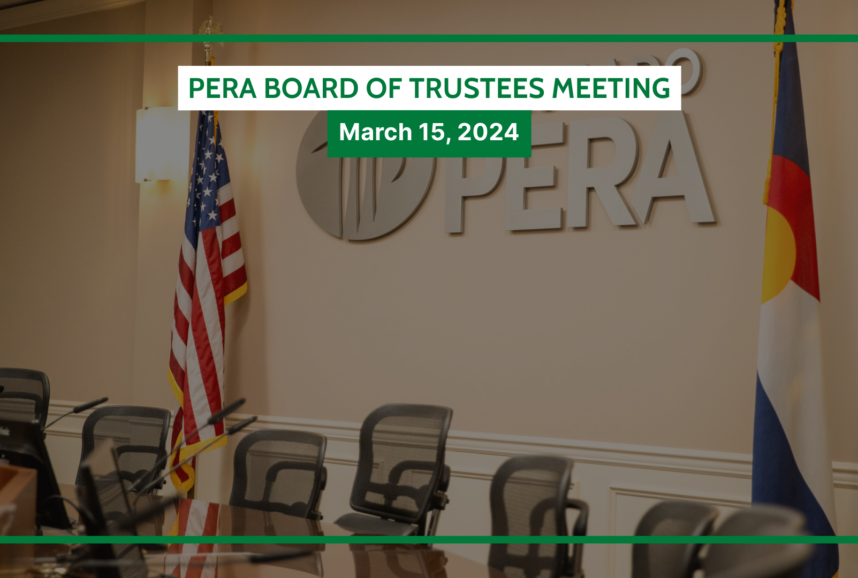Innovative strategies for responding to changing
demographics and market conditions are keeping public retirement plans
sustainable, and Colorado PERA is a leading example, according to a new report
from the Center for State and Local
Government Excellence
(SLGE) and AARP.
Since
the recession in 2008, many retirement systems have struggled with changing
demographics and reduced expectations for their investment returns, resulting
in lower funded ratios for their pension plans. In many cases, making changes
to address these challenges and maintain plan stability required legislative
action.
In response, some plans have created formulas that
give plans the flexibility to make adjustments to their benefits and/or
contributions to maintain long-term stability that do not require unpredictable
or time-consuming legislative changes.
The report
notes that such formulas “enable all stakeholders to understand how, when, and
to what extent contributions or benefits might be subject to formula-based
changes, and as a result, enable them to plan for the long term.”
Legislation passed in 2018 included this type of
provision for PERA, called the automatic
adjustment. Every June, PERA reviews progress toward its funding
goal. If PERA is behind schedule, member and employer contributions will increase,
and the annual increase decreases. If PERA is ahead of schedule, the annual
increase will rise and contributions will decrease.
Prior to that legislation, making any changes to
PERA’s contributions or benefits required legislation. Over the previous 15
years, annual contribution deficiencies resulted in a funding
deficit of $4.6 billion.
The report highlighted PERA’s lengthy research and stakeholder
engagement process. The resulting legislation, Senate Bill 18-200
affected employers, employees and retirees. Together with adjustable
contributions and rate of annual increase, “PERA may be better able to meet its
fiduciary responsibility to ensure all members will receive their earned
pension benefit both in the short and long term.”
The report notes that while the economy has
stabilized since the 2008 recession and many public pension plans have
maintained or improved their funding rates, “relatively stable economic
conditions are not guaranteed to prevail.” However, these variable funding
structures may help pension plans in responding to shifting conditions.
SLGE does not recommend a particular pension
funding structure, according to an article
from PlanSponsor.
FiduciaryA person who manages money on someone else’s behalf and who has a sworn responsibility to manage those funds in the best interest of the client.





You folks may think “ the economy has stabilized since the 2008 recession and many public pension plans have maintained or improved their funding rates“, but every year I get almost $100, less as my insurance continues to rise and I get no anual cost of living raise. So no, PERA is not maintaining and definitely not improving my pension salary.
Exactly Right, PERA decision to break its contractual agreement, and retro-actively take back a key provision, (the Annual Increase of 3.5%) was a major failure in their stated goal to fully fund their obligations. To date PERA has taken close to $90,000 in benefits from my spouse and myself, which would have been a reasonable offset to the inflation of healthcare costs and other inflationary increases since the 2010 breach of contract with retirees who were fully vested. The guise of “shared sacrifice” was trotted out as a way to placate the current employees, by supposedly spreading the burden to those who already made the sacrifice, completed career and made financial decisions based on stated conditions of retirement benefits in place at the time. You don’t achieve full-funding by simply defaulting on a portion of your obligation. PERA, without some future lump-sum repayment of my earned benefits, cannot claim to have reached “full funding”, whether it’s 30 years or not…….many of us remain unpaid for benefits earned.
The report should not have highlighted PERA’s “stakeholder engagement process. The results of the process were totally ignored in developing Senate Bill 18-200. Most importantly more than 900 people who attended the PERAtour cast their support for statements that started with the phrase: “PERA should be a retirement plan that…” Of the 5 statements, the one with the most support was”…allows retirees to maintain their standard of living throughout their lifetime.” Ninety-one percent of participants agreed or strongly agreed. Most, if not all of those who did not agree did not understand the statement, as evidenced by the quote from one of the participants: “If this means that you should be able to maintain the same standard of living in retirement you had while working, I disagree.”
There is no way retirees will be able to maintain their standard of living with the 1.4% annual COLA dictated by Senate Bill 18-200, and even that meagre amount is likely to be reduced in the years ahead.
I would like to know how divestment from losing stocks, like coal, takes place in a timely manner without waiting a year to divest? If the legislature says you must divest, how long does this take? It seems that coal has been losing money for over a year and this divestment has not taken place.
If the General Assembly were to mandate PERA divest any particular holding from the portfolio, there would likely be a timeline established in the legislation for doing so. Ordering divestment would come with significant cost and it does take time to search for and certify those entities that may have the characteristics or affiliations targeted by a divestment effort. There would be transaction costs incurred in selling or disposing of securities, as well as researching and conducting due diligence for any replacement securities or funds.
PERA: Could you please respond to the following Associated Press article? Please explain how this loss of income was allowed to continue for “about a decade” in the context of your roadmap?
Experts: Retirement agency left Denver building unoccupied for about a decade
ASSOCIATED PRESS
DENVER – Colorado real estate experts say a state agency has left a Denver office building unoccupied for about a decade representing millions in lost potential revenue.
The Denver Post reports that the five-floor Capitol Hill building is one of three owned by the state Public Employee Retirement Association.
The agency manages the retirement fund for about 600,000 current and former public employees and retirees.
Officials say the agency has lost $1.8 billion on investments in 2018, and the losses cost the workers who pay into the agency and the retirees who receive benefits.
Appraisers say the building would be worth about $8 million in a sale. An agency spokesperson says they have been looking for a tenant for over two years, but have been unsuccessful.
Thank you for the opportunity to provide additional context on the 13th & Logan building. When we first consolidated PERA staff into our adjacent building at 13th & Penn, we didn’t market the Logan building, not knowing what our property needs were going to be for a growing staff (we have since expanded the number of staff working at our Westminster location and added a new office in Lone Tree to better serve our members). We have been marketing the building since 2017 and are looking for a highly qualified, credit-worthy, and long-term tenant (and preferably a single tenant for the whole building). We’ve had some interest in the building, but are being highly selective to find the best fit for our long-term needs and plans.